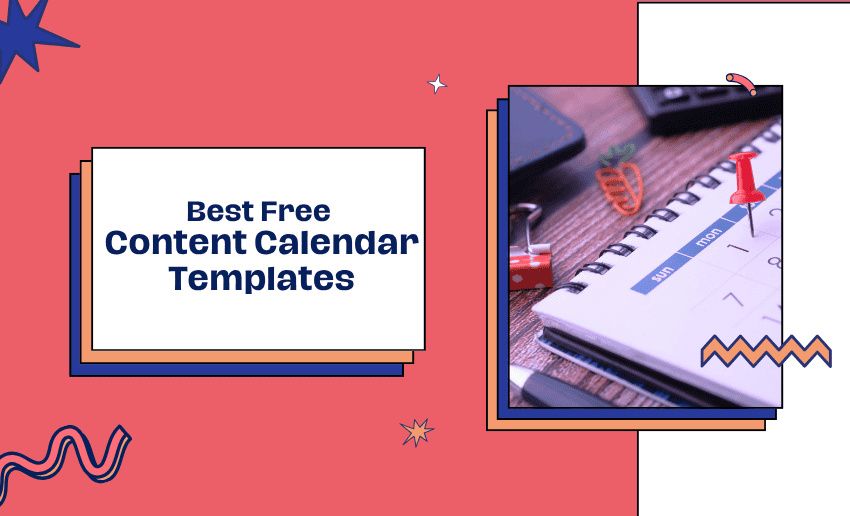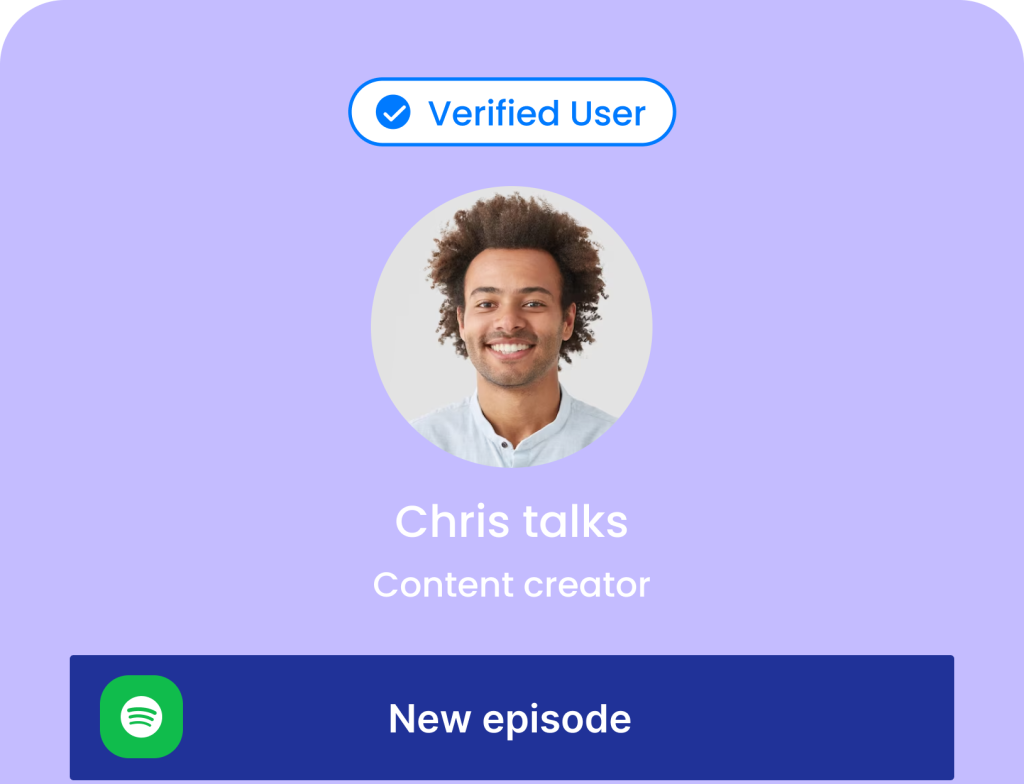Planning posts, meeting deadlines and staying consistent across all social platforms is never an easy task. But with a content calendar, creators can easily turn these tedious tasks into a walk in the park. A content calendar is simply a tool that helps you organize what to post, when to post it, and where it should go.
It allows creators, marketers, and businesses to plan their content ahead of time so nothing feels rushed or random. Using content calendar examples or templates not only saves you time but also ensures you get started with minimal efforts. Whether you’re managing a brand page or a personal profile, having a structured plan makes your strategy smoother and more effective.
In this guide, you’ll find content calendar templates that you can copy, customize, and use right away. You’ll also learn how to design your own editable content calendar that fits your unique workflow and content style.
Why every creator needs a content calendar
With content calendar templates or editable content calendars, you can create a clear roadmap that keeps your creativity flowing and your audience engaged. Every creator needs a content calendar for several reasons. It helps you plan posts strategically instead of guessing what to share each day, saving both time and effort. Other benefits include:
1. Stay organized and avoid chaos
A content calendar brings order to what can otherwise feel chaotic. When you map out your posts in advance, you won’t scramble to find something to post at the last minute. With a well-structured editable content calendar, you can see all upcoming content at a glance with dates, topics, and platforms so nothing slips through the cracks. This organization gives you mental space to focus on quality instead of stress.
2. Maintain consistency across platforms
One of the biggest challenges in content marketing is staying consistent, posting regularly and with a unified voice. Using content calendar templates or a social media calendar template, you can schedule posts ahead and ensure you don’t have long content droughts. Consistency builds trust with your audience, reinforces your brand image, and keeps people coming back to see what’s next.
3. Save time through batch work
When you use a content calendar template to guide you, you can batch-create multiple posts in one session write, design, schedule rather than jumping between tasks daily. That means less context switching, fewer distractions, and more deep focus time. Over weeks, those saved minutes add up to hours. Having a plan via templates or calendars removes the daily “what do I post today?” hurdle.
4. Align content with strategic goals
A content calendar helps you connect your daily posts with bigger goals for campaigns, launches, seasonal topics, or brand messaging. When you use a calendar to plot ahead, you can place content that supports promotions or product releases, rather than reacting spontaneously. This alignment ensures you’re not just posting for the sake of posting but moving toward measurable impact.
5. Improve collaboration and accountability
If you work with a team (writers, designers, social media managers), a content calendar becomes your shared framework. With an accessible calendar whether spreadsheet-based or using project tools, everyone knows who does what, when it’s due, and where it lives. This clarity reduces misunderstandings and overlap. You can even share social media calendar templates with collaborators so that the whole team stays on the same page.
6. Track performance and adapt
A calendar is more than just scheduling; it becomes your record of what’s been posted, when, and where. By keeping track of metrics (views, engagement, shares) tied to each content slot, you can analyze what’s working and what’s not. Over time, that insight helps you refine your strategy. Because your calendar is editable, you can adjust, pause, or reshuffle content based on what the data tells you.
Best free content calendar examples
A good content calendar is a clear roadmap that keeps your ideas, deadlines, and goals organized in one place. Your content calendar should include the right elements to help you plan smarter, track progress easily, and stay consistent across all platforms.
Whether you use content calendar templates or build your own editable content calendar, having the essential components ensure your strategy runs smoothly from idea to publication. Also, the strength of a content calendar lies in its adaptability. Therefore creators must be able to start simple before moving on to customize as needed.
1. Pushbio
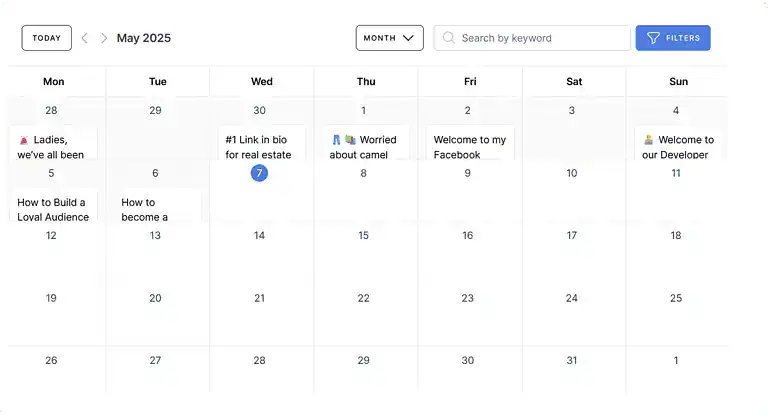
Pushbio is an all-in-one platform designed to help creators, influencers, and businesses streamline their online activities. Beyond its popular bio link, storefront, and monetization tools, Pushbio includes a powerful social media content calendar + scheduler that lets users plan, publish, and manage posts across multiple platforms like Instagram, TikTok, Facebook, and LinkedIn. It’s a practical choice for anyone looking to organize content using an editable content calendar without juggling multiple apps.
What makes Pushbio different from other social media calendar templates is its simplicity and automation. The clean, intuitive dashboard allows users to connect all their accounts, create posts directly in the editor, and set precise publishing times all while previewing how posts will appear. Its built-in AI Assist feature helps refine captions, add emojis, and generate creative post ideas, ensuring every piece of content aligns with your brand tone.
Key features
- Link several social accounts and manage them from one unified space.
- Choose exact dates and times for each post, automate publishing, and visualize everything in a calendar view.
- Write captions, insert hashtags, emojis, and upload images or videos without leaving the editor.
- Use artificial intelligence to optimize content, suggest ideas, or rewrite posts creatively.
- Categorize posts by type (e.g., promotional, educational, engagement) and reuse saved templates for faster planning.
- See exactly how your post will appear before it goes live, ensuring a consistent and professional look across all platforms.
Pushbio makes social media planning effortless by blending the power of automation with creativity to help you stay organized, consistent, and ahead of schedule.
2. Google sheets calendar template
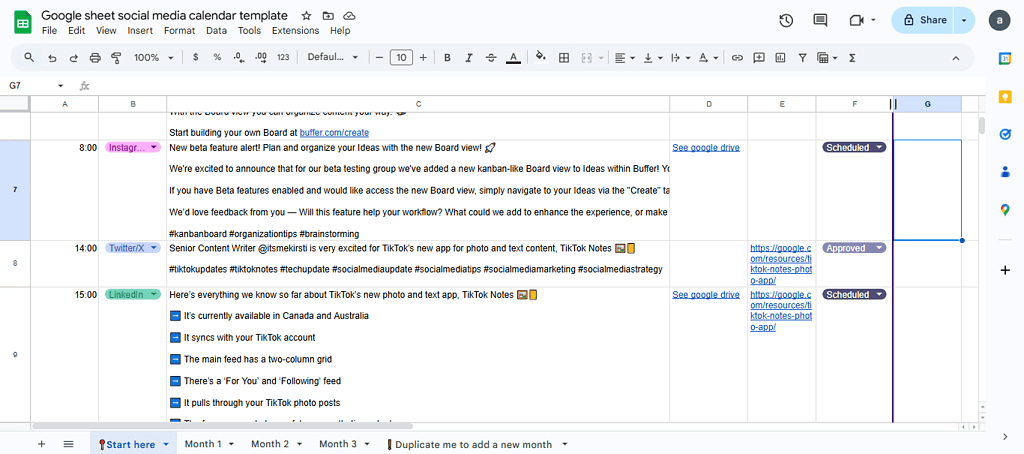
This is a social media planning layout built in Google Sheets. Thanks to Google Sheets’ dropdown list feature, you can pick content types or statuses from a menu rather than typing every time. The flexibility of this editable content calendar makes this one of the most user-friendly options out there.
You can assign custom colors to different dropdown choices (e.g. “planned,” “in progress,” “posted”), giving your calendar visual clarity. Unlike simple note-based templates, this one lets you keep full captions, links, or media references right alongside dates.
Key features
- Dropdown picklists for status, type, or platform
- Color coding for quick visual cues
- Ample space to store full post drafts, captions, or asset links
- Easy to copy and adapt for your own channels
3. Hootsuite’s posting schedule template

Provided by Hootsuite, this template covers multiple platforms (Facebook, Instagram, X, LinkedIn, TikTok) in a single sheet. You can edit it freely to match your specific mix of channels.
Beyond the usual scheduling fields, this template includes a “strategy” tab. You can outline your content goals there and refer back while filling in the calendar. It also has a place for evergreen content posts you can reuse anytime.
Key features
- Preloaded columns for several major social networks
- Strategy or goal reference section
- A tab for evergreen posts ready to plug in
- Fully customizable allowing you to remove or add platforms easily
4. Sprout Social’s monthly calendar layout
Designed as a multi-tab spreadsheet (one tab per week), Sprout Social’s calendar gives you granular control. Each tab includes columns for copy, media, publish date, network with a dropdown, and KPIs.
It dives into more details than most templates, including collaborators, performance metrics, and multiple platforms. This makes it ideal when you want your calendar to double as both a planner and a performance tracker.
Key features
- Week-by-week tabs
- Dropdown menus for network and campaign
- Columns for KPIs, collaborators, and media assets
- High level of detail for planning & tracking
5. Semrush content calendar template
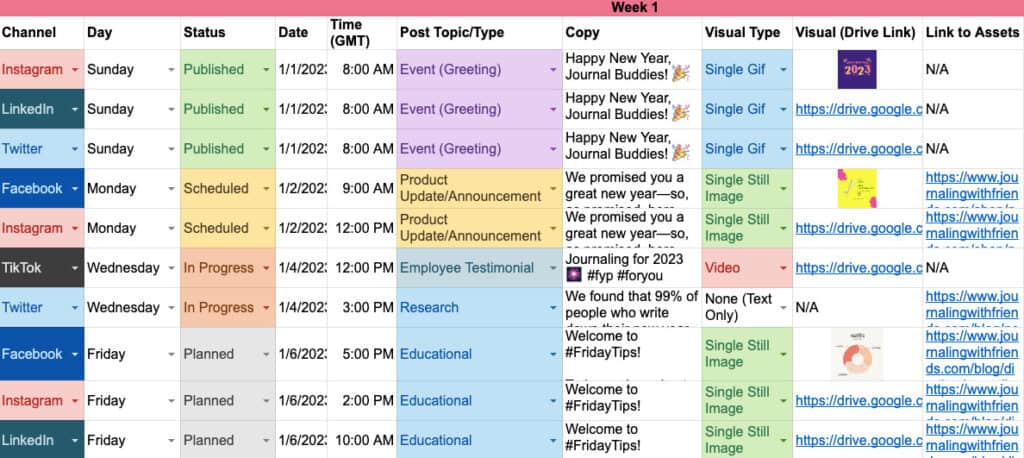
Built as a spreadsheet you can edit, Semrush’s calendar lays out a full schedule for your social media posts including day, time, platform, topic, media, links, and status.
What’s unique is its long-term view: it supports planning across months (even filling out a full year) and includes example content to help new users. You can also quickly grasp upcoming content types through color coding.
Key features
- Year-long planning structure
- Color-coded categories or post types
- Comprehensive columns for all relevant content details
- Sample entries for inspiration
6. Later’s free content calendar template
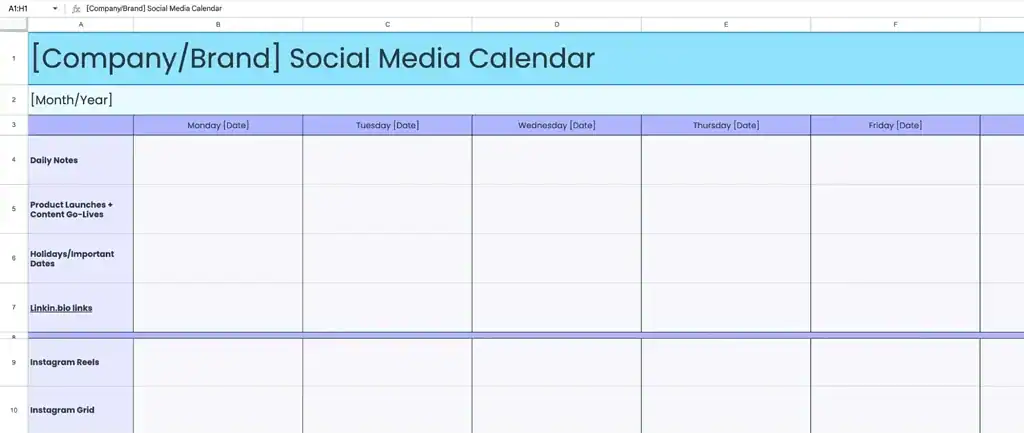
Later offers a weekly planning sheet as an editable template. It includes an instruction tab and example layout so first-time users know where to start.
Later makes the template beginner-friendly by embedding help and examples directly inside. This improves usability, especially for creators new to planning with social media calendar templates.
Key features
- Instructional tab built in
- Example daily layout for reference
- Editable fields for copy, visuals, and scheduling
- Clean and easy to adapt
7. Canva’s social media calendar template
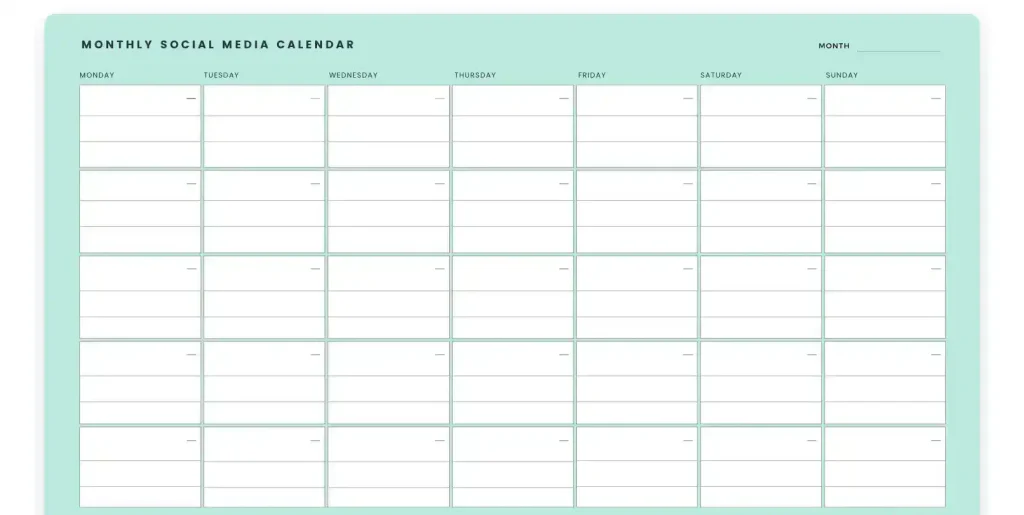
If you prefer visual flair, Canva lets you design your own calendar or pick one from its template gallery. Then you can insert your dates, post types, and assets visually.
Thanks to Canva’s strength in design, you get both function and style. You can customize exactly what appears in your editorial calendar and make it look good. It’s ideal when you want to blend planning and branding in one view.
Key features
- Drag-and-drop design flexibility
- Ability to include images, icons, and visual assets inline
- Editable layout for weeks, months, or custom spans
- Template library and blank canvases
8. SocialBee’s content calendar
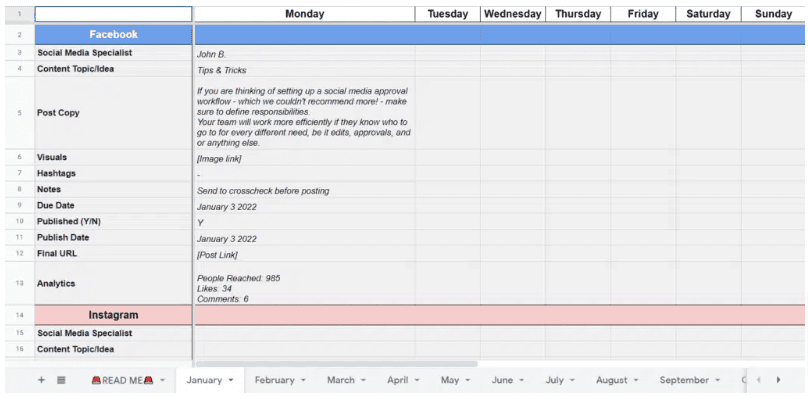
SocialBee gives you a full-year editable calendar with tabs for each month and built-in post suggestions. It’s not just a schedule, it’s a creative prompt tool. Alongside monthly tabs, you’ll find extra sheets filled with ideas: fun, inspirational, educational, promotional, interactive. Great for when you hit a creative dry spell.
Key features
- 12 monthly tabs
- Dozens of post ideas per category
- Editable so you can add or remove ideas
- Ideal for long-term planning
9. Adobe Express’ interactive calendar
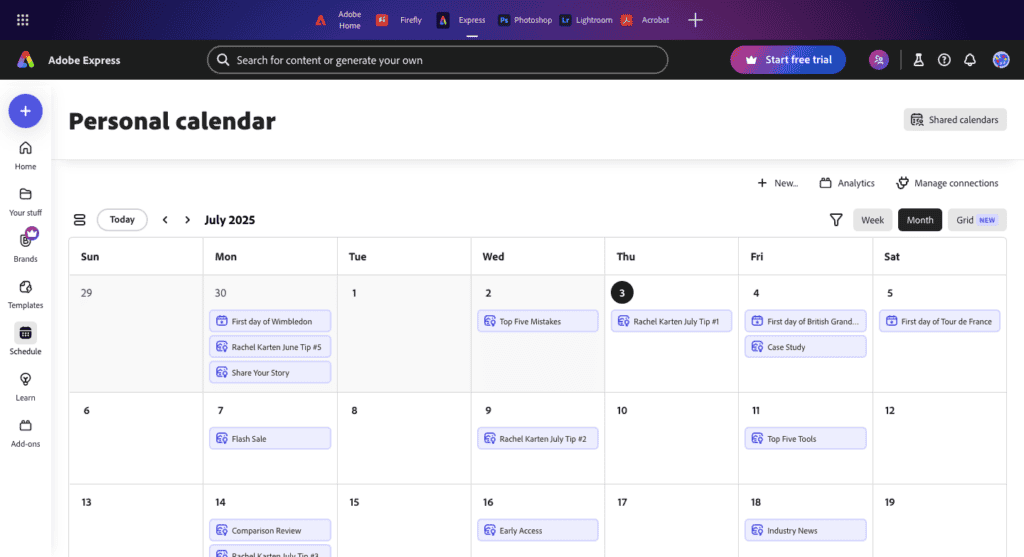
Rather than a plain sheet, Adobe Express offers an interactive calendar tool. You can plan, review, and schedule social content from this single interface.
Beyond scheduling, it integrates with analytics tools so you can check performance without leaving the calendar. This bridges planning and measurement.
Key features
- Integrated scheduling interface
- Platform support for Facebook, Instagram, LinkedIn, TikTok, Pinterest, X
- Link to analytics tools
- Review and planning in one place
10. Monday.com’s content planning template
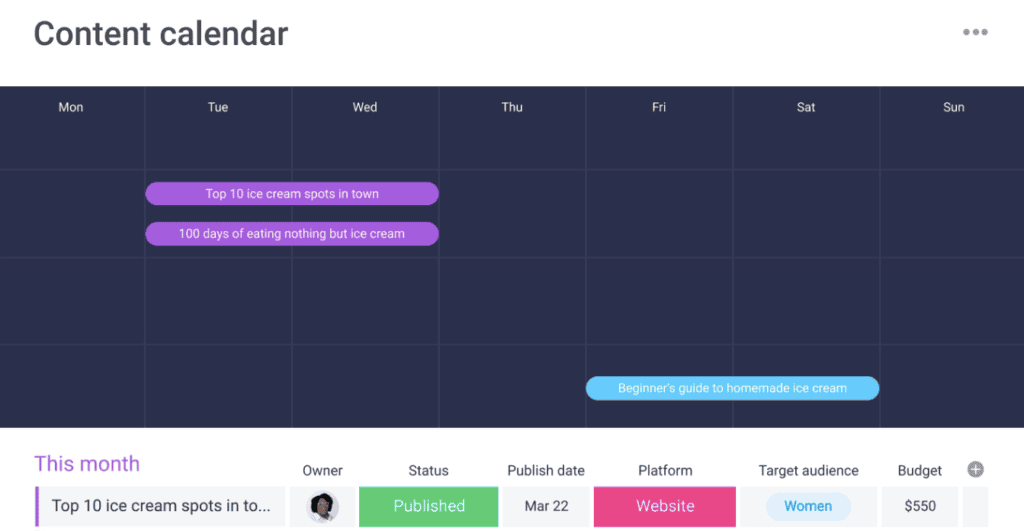
If you already use Monday.com for project management, this content calendar template brings all your content work into the same workspace.
It includes task-level automations (e.g. reminders) and multiple views (table, Kanban, timeline), so your content planning feels like project management—smooth and visual.
Key features
- Automations and reminders
- Multiple view types (calendar, timeline, Kanban)
- Task and content integration
- Collaboration built-in
11. Iconosquare’s quarterly calendar
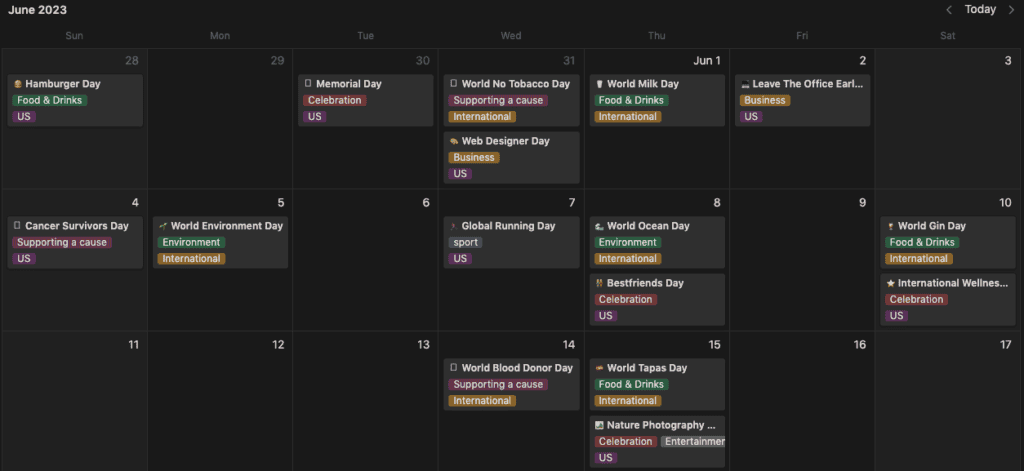
Iconosquare gives you a calendar view formatted for Notion and Google Calendar. It includes events, holiday prompts, and popular hashtag ideas pre-loaded.
Instead of starting with blank dates, you already get global holidays and fun events filled in. It helps spark content ideas as you build your calendar.
Key features
- Calendar view in Notion / Google Calendar
- Pre-populated holidays and event ideas
- Export as PDF, HTML, or Markdown
- Editable to extend beyond the provided timeframe
12. AI-generated content calendar
An AI-generated content calendar uses artificial intelligence tools like ChatGPT, GPT-enhanced Google Sheets, or automated calendar generators to plan, organize, and optimize your content. Instead of manually building schedules, these content calendar templates use smart algorithms to create post ideas, outlines, and publishing timelines based on your goals, platforms, and audience preferences.
What makes AI-powered planners unique is their ability to blend automation with personalization. Since they don’t just fill dates, they understand your content style, audience tone, and posting rhythm.
Key features
- Smart suggestions to generate post ideas, captions, and hashtags automatically.
- Get tailored content plans for Instagram, TikTok, YouTube, and more.
- Leverage prompt integration in Google Sheets.
- Fully customizable to adjust tone, goals, or campaign types anytime.
How to customize content calendar templates for your brand
Customizing content calendar templates is the key to making your strategy truly reflect your brand’s identity and goals. Instead of using generic layouts, you can adjust colors, categories, and posting schedules to match your audience and message.
To personalize these content calendar examples, follow these steps:
1. Define your brand voice and style guidelines
Before customizing any social media calendar template, decide what your brand sounds and looks like. Choose your brand tone (friendly, professional, playful), fonts, colors, and image style. Then, when filling out an editable content calendar, use those guidelines consistently. For example, reserve one color for “educational posts,” another for “promotion,” and match them to your brand palette. This consistency helps your audience instantly recognize your content, even before reading the text.
2. Choose your core content pillars
Select 3–5 main themes or “pillars” that represent your brand. This can be tutorials, behind-the-scenes, testimonials, tips, industry news. Then tweak your preferred template so that each day or week slot corresponds to one pillar. This structure ensures you cover your key themes regularly without randomness, and over time lets you see which pillar works best by comparing performance across these categories.
3. Tailor scheduling to your audience behavior
A template may have default posting times or frequencies, but those may not match your audience’s habits. Use your analytics to find when your followers are most active or responsive, then adjust publish dates and times in your content calendar accordingly. For instance, if your audience is most active in evenings on Instagram and mornings on LinkedIn, reflect that in your schedule fields. This tweak makes your content calendar examples more effective, rather than generic.
4. Add brand-specific columns and fields
Don’t just stick with what the template gives you; pad it with extra columns you need. Maybe you want a “Call-to-Action,” “Mood of Visual,” “Cross-Promotion Link,” or “Repurpose Plan” column. In your editable content calendar, insert these custom fields so your team (or you, if you’re solo) always knows extra details without guesswork. Over time, you can refine or remove fields you never use.
5. Review, test, and iterate regularly
No calendar is perfect from the start. Set aside time (weekly or monthly) to review what content types shine and which flops; then tweak your template accordingly. Use results from your performance metrics to adjust future posts, change or drop weak content pillars, or add seasonal variations. Because your calendar is editable, you can refine it as you go. This continual improvement transforms a simple content calendar template into a powerful strategy tool rather than a static schedule.
In summary
A well-structured content calendar is one of the smartest tools any creator, marketer, or business can use to stay organized and consistent. It helps you plan ahead, manage multiple platforms effortlessly, and maintain a steady flow of engaging content.
Also, we’ve given you 12 content calendar examples to pick from so you don’t have to start from scratch. using these content calendar examples and templates, you can plan smarter, stay consistent, and grow your online presence without feeling overwhelmed.



